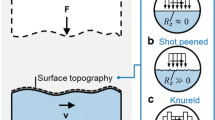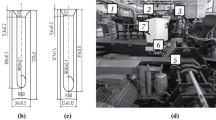Abstract
The work aims to improve the quality of workpieces obtained by breaking rolled stock products by researching the separation process under dynamic and static-dynamic loading on a press-hammer. Combined static-dynamic loading during cold breaking by bending allows to reduce of high-frequency vibrations of the “tool-specimen-support” system, to eliminate the violation of the contact of the specimen with the supports, and to reduce the peak values of the forces from the side of a punch and supports. The static force at the moment of impact provides a certain initial level of tensile stresses in the area of the stress concentrator. This has a positive effect on the quality of the obtained workpieces. The magnitude of the static force required to exclude the separation of the specimen from the supports depends on the stiffness of the contact between the head and the intermediate punch and increases with increasing this stiffness. The obtained experimental results confirm the adequacy of the mathematical model of specimen separation by the breaking method under dynamic and static-dynamic loading. It has been experimentally established that the value of the preliminary static force must be at least 40% of the force at which the specimen is broken down. Obtained results can be used to improve the technology of separating rolled stock into dimensional workpieces by the method of cold breaking by bending.











Similar content being viewed by others
Availability of data and material
Not applicable.
Code availability
Not applicable.
References
Lisunets NL (2019) Usage of physical and mathematical simulation for improvement of the processes of metal shear cutting. CIS Iron and Steel Review 17:34–38
Karnaukh SG, Chosta NV, Markov OE et al (2021) Development and research of the press operating mechanism, made in the form of the wedge-joint mechanism with a curving wedge for separation operations. https://doi.org/10.1007/s00170-021-07718-8
Lisunets NL (2018) Improving the efficiency of the processes of billets manufacture from rolled metal via shift cutting based on simulation, Chernye. Metally 6:31–35
Lisunets NL, Demetrashvili IS, Goyi HM (2018) Development and characterization of the manufacturing process of cylindrical-shaped semi-finished products from non-ferrous alloys for stamping on the basis of modeling. Tsvetnye Metally 5:82–85
Karnaukh SG, Markov OE, Aliieva LI, Kukhar VV (2020) Designing and researching of the equipment for cutting by breaking of rolled stock. Int J Adv Manuf Technol 109(9–12):2457–2464
Liu Y, Hua L, Mao H, Feng W (2014) Finite element simulation of effect of part shape on forming quality in fine-blanking process. Procedia Engineering 81:1108–1113
Zheng Q, Zhuang X, Zhao Z (2019) State-of-the-art and future challenge in fine-blanking technology. Prod Eng Res Devel 13:61–70
Hu XH, Choi KS, Sun X, Golovashchenko SF (2014) Edge fracture prediction of traditional and advanced trimming processes for AA6111-T4 sheets. J Manuf Sci Eng 136(021016):11
Zhao PJ, Chen ZH, Dong CF (2016) Experimental and numerical analysis of micromechanical damage for DP600 steel in fine-blanking process. J Mater Process Technol 236:16–25
Wang S, Chen Z, Dong C (2017) Tearing failure of ultra-thin sheet-metal involving size effect in blanking process: Analysis based on modified GTN model. Int J Mech Sci 133:288–302
Barik J, Sonkamble V, Narasimhan K (2018) Burr formation and shear strain field evolution studies during sheet metal blanking. IOP Conf Ser Mater Sci Eng 418(012068):8
Tanaka T, Hagihara S, Tadano Y, Inada T, Mori T, Fuchiwaki K (2013) Application of finite element method to analysis of ductile fracture criteria for punched cutting surfaces. Mater Trans 54:1697–1702
Olguner S, Bozdana AT (2017) Influence of press ram pulsation on deep drawability of dual phase steel sheet. Acta Phys Pol, A 132:742–745
Grishaev VV, Vysotskii EN (1994) Crack propagation in a rod in alternating plastic bending. Strength Mater 26(2):153–156
Xiao Y, Zhang J, Xiang Xu, Liu Z, Zhao W (2021) Dynamic stress propagation induced transition of stress state and microstructure characteristics during high-speed cutting of OFHC copper. The International Journal of Advanced Manufacturing Technology 115:2365–2378
Finkel VM, Rodyukov GB, Golovin YI (1982) Cold breakage of rolling. Moscow: Metallurgy 192s
Yanshan L, Sung JL, Hoon H (2013) Prediction of fracture forming limit for DP780 steel sheet. Met Mater Int 4(19):697–705. UCI: G704–000797.2013.19.4.030
Solovtsov SS (2005) Manufacture of precise billets by cutting and punching. Kuznechno-Shtampovochnoe Proizvodstvo (Obrabotka Metallov Davleniem) 9:22–24
Park N, Huh H (2016) Modeling of a Ductile Fracture Criterion for Sheet Metal Considering Anisotropy. Trans Mater Process 2(25):91–95. UCI: G704–000097.2016.25.2.008
Won C, Lee W, Lee H et al (2020) Effect of two-stage press blanking on edge stretchability with third-generation advanced high-strength steels. The International Journal of Advanced Manufacturing Technology 110:13–27
Krinninger M, Opritescu D, Golle R et al (2017) On the opportunities of problem- and process-adapted shear cutting simulations for effective process design. Procedia Engineering 207:1570–1575
Krobath M, Klünsner T, Ecker W et al (2018) Tensile stresses in fine blanking tools and their relevance to tool fracture behavior. Int J Mach Tools Manuf 126:44–50
Karnaukh SG, Markov OE, Kukhar VV, Shapoval AA (2022) Classification of steels according to their sensitivity to fracture using a synergetic model. Int J Adv Manuf Technol. https://doi.org/10.1007/s00170-022-08653-y
Tarasov AF (1998) Cheng Kung Je. Li Wu, Pao Hsueh, The statico-dynamic forming of powders preforms on press-hammers, Journal of Engineering Thermophysics 19(6):5–9
Kondryakov E, Panasenko O, Kravchyk A, Kharchenko V (2019) Peculiarities of the crack initiation and propagation in different specimen types. Procedia Structural Integrity 16:43–50
Kravchuk AV, Kondryakov EO, Panasenko OV, Kharchenko VV (2017) Determination of the temperature dependences of the fracture energy components of specimens of various types in impact bending tests. Strength Mater 49(6):809–817
Kudrya AV, Sokolovskaya EA, Ha NN, Kuzko EI, Kotishevsky GV (2019) Forecast of fracture of large forgings with a heterogeneous structure. Electrometallurgy 6:33–39
Kudrya AV, Sokolovskaya EA, Perezhogin VYu (2019) Ngo Ngoc Ha. Some practical considerations related to computer procedures for image processing in materials, Vector TSU 4(50):35–44
Kudrya AV, Sokolovskaya EA (2018) Ninh Hai Le, Ha Ngoc Ngo. Relationship between the morphology of viscous fractures of nature and the properties of structural steels, Metal Science and Heat Treatment of Metals 4:35–41
Kudrya AV, Sokolovskaya EA, Akhmedova TSh, Perezhogin VYu (2017) Heterogeneity of structures and destruction of iron-based hard alloys and their measurement. Electrometallurgy 6:32–40
Trąbka A (2019) Effect of pulse shape and duration on dynamic response of a forging system. Acta Mechanica et Automatica 13(4):226–232. https://doi.org/10.2478/ama-2019-0030
Saberi S, Fischer J, Stockinger M et al (2021) Theoretical and experimental investigations of mechanical vibrations of hot hammer forging. The International Journal of Advanced Manufacturing Technology 114:3037–3045
Krasovsky AY, Orynyak IV, Naumov AV (1989) On the dynamics of the process of impact testing of specimens for concentrated bending. Problems of strength 5:25–29
Krasovsky AY, Orynyak IV, Naumov AV (1989) On the dynamics of the process of impact testing of specimens for concentrated bending. Problems of strength 6:3–7
Rokach IV (1992) On numerical simulation of experiments to determine the dynamic crack resistance of materials. Problems of strength 7:22–26
Karnauh S, Karnaukh D (2011) Research of the influence of deformation speed on energy and power adjectives of the process of three-point cold bend breaking and on alignment integrity of raw parts. Metallurgical and Mining Industry 3(7):107–114
Kharchenko V, Kondryakov E, Panasenko A (2015) Experimental investigation of the crack-initiation moment of charpy specimens under impact loading. Materiali in Tehnologije 49(3):403–408
Kondryakov EA, Panasenko AV, Kharchenko VV (2015) Experimental determination of the moment of fracture initiation in standard Charpy specimens and specimens with edge notches. Strength Mater 47(2):291–296
Author information
Authors and Affiliations
Contributions
By Sergii G. Karnaukh: mathematical modeling of the dynamic and static-dynamic breaking of rolled stock according to the three-point bending scheme. By Oleg E. Markov: experimental studies of the separating long products according to the three-point bending scheme under dynamic and static-dynamic loading. By Volodymyr V. Kukhar: a literature review. By Alexander A. Shapoval: developed research method.
Corresponding author
Ethics declarations
Ethics approval
This manuscript was submitted to only one journal. The submitted work is original and does not have been published elsewhere in any form or language (partially or in full). Results have been presented clearly, honestly, and without fabrication, falsification, or inappropriate data manipulation (including image-based manipulation). Authors adhered to rules for acquiring, selecting, and processing data. Data, text, and theories were the author’s own. Proper acknowledgments to other works were be given and summarized.
Consent to participate
Not applicable.
Consent for publication
Not applicable.
Conflict of interest
The authors declare no competing interests.
Additional information
Publisher's Note
Springer Nature remains neutral with regard to jurisdictional claims in published maps and institutional affiliations.
Rights and permissions
About this article
Cite this article
Karnaukh, S.G., Markov, O.E., Kukhar, V.V. et al. Research of the rolled stock separating into workpieces using breaking by bending with dynamic and static-dynamic force. Int J Adv Manuf Technol 120, 2763–2776 (2022). https://doi.org/10.1007/s00170-022-08902-0
Received:
Accepted:
Published:
Issue Date:
DOI: https://doi.org/10.1007/s00170-022-08902-0




